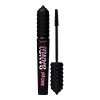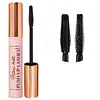Benefit Cosmetics BADgal BANG! Volumizing Mascara Versus Charlotte Tilbury Pillow Talk Push Up Lashes Mascara
What's inside
What's inside
 Key Ingredients
Key Ingredients

 Benefits
Benefits

 Concerns
Concerns

 Ingredients Side-by-side
Ingredients Side-by-side

Water
Skin ConditioningParaffin
PerfumingCera Alba
EmollientGlyceryl Stearate
EmollientButylene Glycol
HumectantAcrylates Copolymer
Euphorbia Cerifera Wax
Copernicia Cerifera Wax
Polybutene
Steareth-21
CleansingVp/Eicosene Copolymer
Palmitic Acid
EmollientStearic Acid
CleansingPhenoxyethanol
PreservativeSteareth-2
EmulsifyingAminomethyl Propanediol
BufferingPanthenol
Skin ConditioningCaprylyl Glycol
EmollientHydroxyethylcellulose
Emulsion StabilisingSilica Silylate
EmollientTocopheryl Acetate
AntioxidantNylon-12
BHT
AntioxidantCI 19140
Cosmetic ColorantCI 42090
Cosmetic ColorantCI 77007
Cosmetic ColorantCI 77163
Cosmetic ColorantCI 77288
Cosmetic ColorantCI 77289
Cosmetic ColorantCI 77491
Cosmetic ColorantCI 77492
Cosmetic ColorantCI 77499
Cosmetic ColorantCI 77510
Cosmetic ColorantCI 77742
Cosmetic ColorantCI 77891
Cosmetic ColorantWater, Paraffin, Cera Alba, Glyceryl Stearate, Butylene Glycol, Acrylates Copolymer, Euphorbia Cerifera Wax, Copernicia Cerifera Wax, Polybutene, Steareth-21, Vp/Eicosene Copolymer, Palmitic Acid, Stearic Acid, Phenoxyethanol, Steareth-2, Aminomethyl Propanediol, Panthenol, Caprylyl Glycol, Hydroxyethylcellulose, Silica Silylate, Tocopheryl Acetate, Nylon-12, BHT, CI 19140, CI 42090, CI 77007, CI 77163, CI 77288, CI 77289, CI 77491, CI 77492, CI 77499, CI 77510, CI 77742, CI 77891
Water
Skin ConditioningCI 77499
Cosmetic ColorantMicrocrystalline Wax
Emulsion StabilisingStearic Acid
CleansingCopernicia Cerifera Cera
EmollientGlyceryl Stearate
EmollientAcrylates Copolymer
Hydrogenated Vegetable Oil
EmollientButylene Glycol
HumectantRicinus Communis Seed Oil
MaskingStearyl Stearate
EmollientCI 77007
Cosmetic ColorantAminomethyl Propanol
BufferingCaprylyl Glycol
EmollientPhenoxyethanol
PreservativeGalactoarabinan
Sodium Dehydroacetate
PreservativeTocopheryl Acetate
AntioxidantLaurdimonium Hydroxypropyl Hydrolyzed Keratin
Skin ConditioningLaureth-21
CleansingBHT
AntioxidantWater, CI 77499, Microcrystalline Wax, Stearic Acid, Copernicia Cerifera Cera, Glyceryl Stearate, Acrylates Copolymer, Hydrogenated Vegetable Oil, Butylene Glycol, Ricinus Communis Seed Oil, Stearyl Stearate, CI 77007, Aminomethyl Propanol, Caprylyl Glycol, Phenoxyethanol, Galactoarabinan, Sodium Dehydroacetate, Tocopheryl Acetate, Laurdimonium Hydroxypropyl Hydrolyzed Keratin, Laureth-21, BHT
 Reviews
Reviews

Ingredients Explained
These ingredients are found in both products.
Ingredients higher up in an ingredient list are typically present in a larger amount.
Acrylates Copolymer is used as a film-forming agent and texture enhancer.
After applied, Acrylates Copolymer forms a thin film cover that helps skin feel more soft. It can help sunscreens become more water-resistant.
It is also used to make a product more thick.
Learn more about Acrylates CopolymerBHT is a synthetic antioxidant and preservative.
As an antioxidant, it helps your body fight off free-radicals. Free-radicals are molecules that may damage your skin cells.
As a preservative, it is used to stabilize products and prevent them from degrading. Specifically, BHT prevents degradation from oxidation.
The concerns related to BHT come from oral studies; this ingredient is currently allowed for use by both the FDA and EU.
However, it was recently restricted for use in the UK as of April 2024.
Learn more about BHTButylene Glycol (or BG) is used within cosmetic products for a few different reasons:
Overall, Butylene Glycol is a safe and well-rounded ingredient that works well with other ingredients.
Though this ingredient works well with most skin types, some people with sensitive skin may experience a reaction such as allergic rashes, closed comedones, or itchiness.
Learn more about Butylene GlycolCaprylyl Glycol is a humectant and emollient, meaning it attracts and preserves moisture.
It is a common ingredient in many products, especially those designed to hydrate skin. The primary benefits are retaining moisture, skin softening, and promoting a healthy skin barrier.
Though Caprylyl Glycol is an alcohol derived from fatty acids, it is not the kind that can dry out skin.
This ingredient is also used as a preservative to extend the life of products. It has slight antimicrobial properties.
Learn more about Caprylyl GlycolThis pigment is called Ultramarine blue lazurite. It gives a saturated blue color, but can be used to create other colors as well.
According to the manufacturer, it is usually made from kaolin, sodium sulfate, sodium carbonate, sulfur, and charcoal.
Ci 77499 is also hydrated iron III oxide. It is created from mixing red and black iron oxides. This helps give shades of darkness to a product.
Iron III oxides are classified as inorganic chemicals for coloring.
Glyceryl Stearate is a mix of glycerin and stearic acid.
It is used to stabilize the mixing of water and oil ingredients. By preventing these ingredients from separating, it can help elongate shelf life. It can also help thicken the product's texture.
As an emollient, it helps soften skin and supports barrier-replenishing ingredients.
In cosmetics, Glyceryl Stearate is often made from vegetable oils or synthetically produced.
This ingredient may not be fungal-acne safe
Fun fact: The human body also creates Glyceryl Stearate naturally.
Learn more about Glyceryl StearatePhenoxyethanol is a preservative that has germicide, antimicrobial, and aromatic properties. Studies show that phenoxyethanol can prevent microbial growth. By itself, it has a scent that is similar to that of a rose.
It's often used in formulations along with Caprylyl Glycol to preserve the shelf life of products.
Stearic Acid is a fatty acid. It is an emollient, emulsifier, and texture enhancer.
As an emollient, stearic acid helps soften skin. It aids the skin's protective barrier by preventing water loss. It also provides a gentle cleansing effect without stripping away natural oils.
Stearic acid may also be used to enhance the texture of products. It can add volume and stabilize ingredients such as water and oil. This can help water and oil ingredients from separating.
Sources of stearic acid include animal or vegetable fats/oils such as coconut or shea. It can be naturally found in butter, cocoa butter, shea butter, vegetable fats, and animal tallow.
This ingredient may not be Malassezia folliculitis, or fungal-acne safe.
Learn more about Stearic AcidTocopheryl Acetate is AKA Vitamin E. It is an antioxidant and protects your skin from free radicals. Free radicals damage the skin by breaking down collagen.
One study found using Tocopheryl Acetate with Vitamin C decreased the number of sunburned cells.
Tocopheryl Acetate is commonly found in both skincare and dietary supplements.
Learn more about Tocopheryl AcetateWater. It's the most common cosmetic ingredient of all. You'll usually see it at the top of ingredient lists, meaning that it makes up the largest part of the product.
So why is it so popular? Water most often acts as a solvent - this means that it helps dissolve other ingredients into the formulation.
You'll also recognize water as that liquid we all need to stay alive. If you see this, drink a glass of water. Stay hydrated!
Learn more about Water